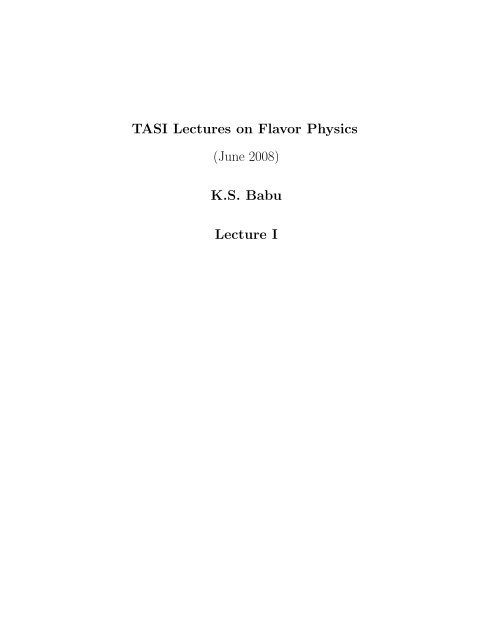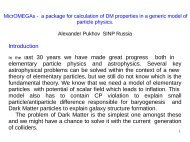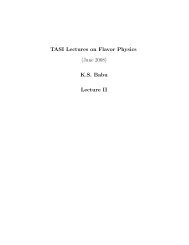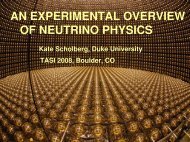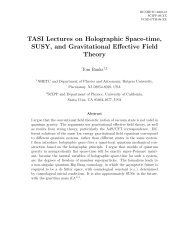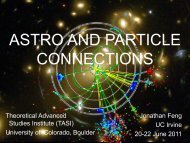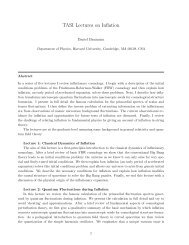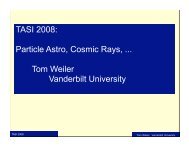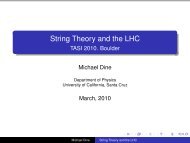TASI Lectures on Flavor Physics (June 2008) - University of ...
TASI Lectures on Flavor Physics (June 2008) - University of ...
TASI Lectures on Flavor Physics (June 2008) - University of ...
Create successful ePaper yourself
Turn your PDF publications into a flip-book with our unique Google optimized e-Paper software.
<str<strong>on</strong>g>TASI</str<strong>on</strong>g> <str<strong>on</strong>g>Lectures</str<strong>on</strong>g> <strong>on</strong> <strong>Flavor</strong> <strong>Physics</strong>(<strong>June</strong> <strong>2008</strong>)K.S. BabuLecture I
§1. OverviewThis set <strong>of</strong> lectures will focus <strong>on</strong> the flavor sector <strong>of</strong> the Standard Model (SM). As you know,most <strong>of</strong> the free parameters <strong>of</strong> the SM reside in this sector. In case you have not thought <strong>of</strong> itlately, let me remind you <strong>of</strong> the counting <strong>of</strong> parameters. Not including neutrino masses, thereare 19 parameters in the SM. Five <strong>of</strong> these are flavor universal – the three gauge couplings,<strong>on</strong>e Higgs quartic coupling λ, and <strong>on</strong>e Higgs mass-squared µ 2 , while the remaining fourteen areflavor parameters. Six quark masses, three charged lept<strong>on</strong> masses, four quark mixing parameters(includes <strong>on</strong>e CP violating phase) make up thirteen, while the str<strong>on</strong>g CP violating parameterθ, which is intimately related to the quark masses, is the fourteenth flavor parameter. If weinclude small neutrino masses and neutrino mixings, as suggested by experiments, an additi<strong>on</strong>alnine parameters will have to be introduced (three neutrino masses, three neutrino mixing anglesand three CP violating phases, in the case <strong>of</strong> Majorana neutrinos).While there is abundant informati<strong>on</strong> <strong>on</strong> the numerical values these parameters take, afundamental understanding <strong>of</strong> the parameters is currently lacking. Why are there so manyfree parameters? Why do these parameters exhibit a str<strong>on</strong>g hierarchical structure spanningsome six orders <strong>of</strong> magnitude? Are the mixing parameters related to the mass ratios? Whyis θ < 10 −9 ? What is the origin <strong>of</strong> CP violati<strong>on</strong>? The lack <strong>of</strong> understanding <strong>of</strong> such issues is<strong>of</strong>ten referred to as the “flavor puzzle”. Various soluti<strong>on</strong>s to this puzzle have been proposed,inevitably leading to bey<strong>on</strong>d the Standard Model, for within the SM these parameters can <strong>on</strong>lybe accommodated, and not explained. Forthcoming experiments, especially at the LHC, havethe potential to c<strong>on</strong>firm or refute many, but not all, <strong>of</strong> these proposed n<strong>on</strong>–standard scenarios.The Higgs bos<strong>on</strong> is waiting to be discovered at the LHC. Its producti<strong>on</strong> and decay rates canbe significantly modified relative to the SM expectati<strong>on</strong>s in some <strong>of</strong> the flavor–extensi<strong>on</strong>s <strong>of</strong>the SM. I will describe explicit models in this category. Very little is known about the topquark properties currently. LHC will serve as a top factory where modificati<strong>on</strong>s in the topsector arising from flavor–extensi<strong>on</strong>s can be studied. We have learned a lot about the B mes<strong>on</strong>system from the B factories lately, but there are still many open issues which will be probed atthe LHC. These include precise determinati<strong>on</strong>s <strong>of</strong> the CP violating parameters, rare processesallowed in the SM but not yet observed, and new physics processes in B decays that requiremodificati<strong>on</strong> <strong>of</strong> the SM structure.In Lecture I, we will take a tour <strong>of</strong> the flavor parameters <strong>of</strong> the SM and review how these aremeasured and interpreted. Various ideas attempting to understand aspects <strong>of</strong> the flavor puzzlewill then be introduced. Experimental c<strong>on</strong>sequences <strong>of</strong> these ideas will be outlined. In LectureII we will pursue such ideas further and seek their tests. Lecture III will be devoted to thestatus and expectati<strong>on</strong>s <strong>of</strong> the Standard Model quark mixings and CP violati<strong>on</strong>. Lecture IV will1
deal with bey<strong>on</strong>d the SM scenarios for the flavor sector and their experimental manifestati<strong>on</strong>sat the LHC.§2. <strong>Flavor</strong> structure <strong>of</strong> the Standard ModelFermi<strong>on</strong> masses arise in the SM via Yukawa interacti<strong>on</strong>s given byL Yukawa = Q T Y u u c H − Q T Y d d c ˜H − L T Y l e c ˜H + h.c. (1)Here I have used the standard notati<strong>on</strong> for quark (Q,u c ,d c ) and lept<strong>on</strong> (L,e c ) fields. (Q, L)are SU(2) L doublets as is the Higgs field H, and its cousin ˜H = iτ 2 H ∗ , while the (u c , d c , e c )fields are SU(2) L singlets. All fermi<strong>on</strong> fields are left–handed, a charge c<strong>on</strong>jugati<strong>on</strong> matrixC is understood to be sandwiched between all <strong>of</strong> the fermi<strong>on</strong> bilinears. C<strong>on</strong>tracti<strong>on</strong> <strong>of</strong> thecolor indices is not displayed, but should be obvious. Y u,d,l are the Yukawa couplings matricesspanning generati<strong>on</strong> space which are complex and n<strong>on</strong>–Hermitian. SU(2) L c<strong>on</strong>tracti<strong>on</strong> betweenthe fermi<strong>on</strong> doublet and Higgs doublet involves the matrix iτ 2 . Explicitly, we have for familylabeled by index iQ i =so that Eq. (1) expands to( ) ( ) ( ui νi H+ ) ( H; L i = ; H = ; ˜H0 )=d i e i H 0 −H −L Yukawa = (Y u ) ij [u i u c jH 0 −d i u c jH + ]+(Y d ) ij [u i d c jH − +d i d c jH 0 ]+(Y l ) ij [ν i e c jH − +e i e c jH 0 ]+h.c. (3)The neutral comp<strong>on</strong>ent <strong>of</strong> H acquires a vacuum expectati<strong>on</strong> value (VEV) 〈H 0 〉 = v, sp<strong>on</strong>taneouslybreaking the electroweak symmetry (v ≃ 174 GeV). The Higgs field can then beparametrized as H 0 = ( h √2+ v) where h is a real physical field (the Higgs bos<strong>on</strong>). In theunitary gauge H ± , which are eaten up by the W ± gauge bos<strong>on</strong>s and the phase <strong>of</strong> H 0 , which iseaten up by the Z 0 gauge bos<strong>on</strong>, do not appear.The VEV <strong>of</strong> H 0 generates the following fermi<strong>on</strong> mass matrices:M u = Y u v, M d = Y d v, M l = Y l v . (4)The Yukawa coupling matrices c<strong>on</strong>tained in (Y u ) ij / √ 2(uu c h), etc in each <strong>of</strong> the up, down andcharged lept<strong>on</strong> sector becomes proporti<strong>on</strong>al to the corresp<strong>on</strong>ding mass matrix. Once the massmatrices are brought to diag<strong>on</strong>al forms, the Yukawa coupling matrices will also be brought todiag<strong>on</strong>al forms. There is thus no tree–level flavor changing current mediated by the neutralHiggs bos<strong>on</strong> in the Standard Model. As we will see, this feature is generally lost as we extendthe SM to address the flavor issue.(2)2
We make unitary rotati<strong>on</strong>s <strong>on</strong> the quark fields in family space. Unitarity <strong>of</strong> these rotati<strong>on</strong>will ensure that the quark kinetic terms remain can<strong>on</strong>ical. Specifically, we define masseigenstates (u 0 ,u c0 ,d 0 ,d c0 ) viaand we choose the unitary matrices such thatVu T(Y u v)V u c = ⎜⎝u = V u u 0 , u c = V u c u c0 ,d = V d d 0 , d c V d c d c0 (5)⎛⎞m um cm t⎟⎠ , V d T(Y d v)V d c = ⎜⎝⎛⎞m dm sm b⎟⎠ . (6)We have assumed here that the number <strong>of</strong> families is three, but the procedure applies to anynumber <strong>of</strong> families. Bi-unitary transformati<strong>on</strong>s such as the <strong>on</strong>es in Eq. (6) can diag<strong>on</strong>alizen<strong>on</strong>–Hermitian matrices. The same transformati<strong>on</strong>s should be applied to all interacti<strong>on</strong>s <strong>of</strong> thequarks. As already noted, this transformati<strong>on</strong> will bring the Yukawa interacti<strong>on</strong>s <strong>of</strong> quarks withthe Higgs bos<strong>on</strong> into diag<strong>on</strong>al form. The couplings <strong>of</strong> the Z 0 bos<strong>on</strong> and the phot<strong>on</strong> to quarkswill have the original diag<strong>on</strong>al form even after this rotati<strong>on</strong>. For example, (uγ µ Iu)Z µ whereI is the identity matrix acting <strong>on</strong> family space will transform to (u 0 γ µ (V †uIV u )u 0 )Z µ , which isidentical to (u 0 γ µ Iu 0 )Z µ . Similarly, (u c γ µ Iu c )Z µ will transform to (u c0 γ µ Iu c0 )Z µ . We see thatthere is no tree level flavor changing neutral current (FCNC) mediated by the Z 0 bos<strong>on</strong> andthe phot<strong>on</strong> in the SM.Most significantly, the transformati<strong>on</strong>s <strong>of</strong> Eq. (6) will bring the charged current quarkinteracti<strong>on</strong>, which originally is <strong>of</strong> the form g/ √ 2(uγ µ d)W +µ + h.c., into the formwhereL cc = g √2[u 0 γ µ V d 0 ] W µ+ + h.c. (7)V = V †uV d (8)is the quark mixing matrix, or the Cabibbo–Kobayashi–Maskawa (CKM) matrix. In the SM,all the flavor violati<strong>on</strong> is c<strong>on</strong>tained in V . Being product <strong>of</strong> unitary matrices, V is itself unitary.This feature has thus far withstood experimental scrutiny, with further scrutiny expected fromLHC experiments.Note that the right–handed rotati<strong>on</strong> matrices V u c and V d c have completely disappeared, aresult <strong>of</strong> the purely left–handed nature <strong>of</strong> charged weak current.We can repeat this process in the lept<strong>on</strong>ic sector. We define, in analogy with Eq. (5),ν = V ν ν 0 , e = V e e 0 , e c = V e c e c0 . (9)3
We choose Y e and Y e c such thatYe T(Y l v)Y e c = ⎜⎝⎛⎞m em µm τ⎟⎠ . (10)Note that there is no right–handed neutrino in the SM. If the Yukawa Lagrangian is asgiven in Eq. (1), there is no neutrino mass. In that case <strong>on</strong>e can choose V ν = V e , so that thecharged current weak interacti<strong>on</strong>s will remain flavor diag<strong>on</strong>al. However, it is now establishedthat neutrinos have small masses. Additi<strong>on</strong>al terms must be added to Eq. (1) in order toaccommodate them. The simplest possibility is to add a n<strong>on</strong>–renormalizable termL ν mass = (LT Y ν L)HHM ∗(11)where the SU(2) L c<strong>on</strong>tracti<strong>on</strong> between the H fields is in the triplet channel and Y ν is a complexsymmetric matrix in generati<strong>on</strong> space. Here M ∗ is a mass scale much above the weak interacti<strong>on</strong>scale. Eq. (11) can arise by integrating out some heavy fields with mass <strong>of</strong> order M ∗ . Themost celebrated realizati<strong>on</strong> <strong>of</strong> this is the seesaw mechanism, where M ∗ corresp<strong>on</strong>ds to the mass<strong>of</strong> the right–handed neutrino. The neutrino masses are suppressed, compared to the chargedfermi<strong>on</strong> masses, because <strong>of</strong> the inverse dependence <strong>on</strong> the heavy scale M ∗ . Right–handedneutrinos, if they exist, are complete singlets <strong>of</strong> the SM gauge symmetry, and can possess bareSM invariant mass terms, unlike any other fermi<strong>on</strong> <strong>of</strong> the SM. This is an elegant explanati<strong>on</strong> <strong>of</strong>why the neutrinos are much lighter than other fermi<strong>on</strong>s, relying <strong>on</strong>ly <strong>on</strong> symmetry principlesand dimensi<strong>on</strong>al analysis. Eq. (11) leads to a light neutrino mass matrix given byM ν = Y νv 2M ∗. (12)Now we choose V ν so thatVν T v 2Y ν V ν = ⎜M⎝∗⎛⎞m 1m 2m 3⎟⎠ , (13)with m 1,2,3 being the tiny masses <strong>of</strong> the three light neutrinos. The lept<strong>on</strong>ic charge currentinteracti<strong>on</strong> now becomesL l cc = g √2[e 0 γ µ Uν 0 ] W −µ + h.c. (14)whereU = V †e V ν (15)4
is the lept<strong>on</strong>ic mixing matrix, or the P<strong>on</strong>tecorvo–Maki–Nakagawa–Sakata (PMNS) matrix.As V , U is also unitary. Neutrino oscillati<strong>on</strong>s observed in experiments are attributed to the<strong>of</strong>f–diag<strong>on</strong>al entries <strong>of</strong> the matrix U. We assumed here that the neutrino mass generati<strong>on</strong>mechanism violated total lept<strong>on</strong> number by two units. While this is very attractive, it shouldbe menti<strong>on</strong>ed that neutrinos could acquire masses very much like the quarks do. That wouldrequire the right–handed ν c states to be part <strong>of</strong> the low energy theory. M ν will then be similar toM l <strong>of</strong> Eq. (10). Neutrino oscillati<strong>on</strong> phenomenology will be identical to the case <strong>of</strong> L–violatingneutrino masses.The fermi<strong>on</strong>ic states (e 0 i) are simply the physical electr<strong>on</strong>, the mu<strong>on</strong>, and the tau lept<strong>on</strong>states. Similarly, the quark fields with a superscript 0 are the mass eigenstates. It is c<strong>on</strong>venti<strong>on</strong>alto drop these superscripts, which we shall do from now <strong>on</strong>.§3. Lept<strong>on</strong> massesC<strong>on</strong>ceptually charged lept<strong>on</strong> masses are the easiest to explain. Lept<strong>on</strong>s are propagatingstates, and their masses are simply the poles in the propagators. Experimental informati<strong>on</strong> <strong>on</strong>charged lept<strong>on</strong> masses is rather accurate:m em µ= 0.510998902 ± 0.000000021 MeV= 105.658357 ± 0.000005 MeVm τ = 1777.03 +0.30−0.26 MeV . (16)The direct kinematic limits <strong>on</strong> the three neutrino masses are:m νe ≤ 3 eV, m νµ ≤ 0.19 MeV, m ντ ≤ 18.2 MeV . (17)Neutrino oscillati<strong>on</strong> experiments have provided much more accurate determinati<strong>on</strong>s <strong>of</strong> thesquared mass differences ∆m 2 ij = m 2 i − m 2 j. Solar and atmospheric neutrino oscillati<strong>on</strong> experimentssuggest the following allowed values (with 2σ error quoted):∆m 2 21 = (7.3 − 8.1) × 10 −5 eV 2∆m 2 31 = ±(2.1 − 2.7) × 10 −3 eV 2 . (18)While this still leaves some room for the absolute masses, when combined with the direct limit<strong>on</strong> m νe ≤ 3 eV, the opti<strong>on</strong>s are limited. Current data allows for two possible ordering <strong>of</strong> themass hierarchies: (i) normal hierarchy where m 1 ≤ m 2 ≪ m 3 , and inverted hierarchy wherem 1 ≃ m 2 ≫ m 3 .§4. Lept<strong>on</strong>ic mixing matrixThe PMNS matrix, being unitary, has N 2 independent comp<strong>on</strong>ents for N families <strong>of</strong> lept<strong>on</strong>s.Out <strong>of</strong> these, N(N − 1)/2 are Euler angles, while the remaining N(N + 1)/2 are phases. Many5
<strong>of</strong> these phases can be absorbed into the fermi<strong>on</strong>ic fields and removed. If <strong>on</strong>e writes U = QÛP,where P and Q are diag<strong>on</strong>al phase matrices, then by redefining the phases <strong>of</strong> e fields Q,which has N phases, can be removed. P has <strong>on</strong>ly N − 1 n<strong>on</strong>–removable phases. For N = 3,P = diag.(e iα , e iβ , 1). α,β are called the Majorana phases. (If the neutrino masses are <strong>of</strong>the Dirac type, these phases can also be removed by redefining the ν c fields.)Û will then haveN(N + 1)/2 − (2N − 1) = 1 (N − 1)(N − 2) phases. For N = 3, there is a single “Dirac” phase2in U.In general, the PMNS matrix can be written as⎛⎞U e1 U e2 U e3U = ⎜⎝ U µ1 U µ2 U µ3⎟⎠ . (19)U τ1 U τ2 U τ3To enforce the unitarity relati<strong>on</strong>s it is c<strong>on</strong>venient to adopt specific parametrizati<strong>on</strong>s. TheEuler angles, as you know, can be parametrized in many different ways. Furthermore, theDirac phase can be chosen to appear in different ways (by field redefiniti<strong>on</strong>s). The “standardparametrizati<strong>on</strong>” that is now widely used has U PMNS = U.P where⎛c 12 c 13 s 12 c 13 s 13 e −iδ ⎞U = ⎜⎝ −s 12 c 23 − c 12 s 23 s 13 e iδ c 12 c 23 − s 12 s 23 s 13 e iδ s 23 c 13⎟⎠ . (20)s 12 s 23 − c 12 c 23 s 13 e iδ −c 12 s 23 − s 12 c 23 s 13 e iδ c 23 c 13Here s ij = sin θ ij , c ij = cos θ ij .Our current understanding <strong>of</strong> these mixing angles arising from neutrino oscillati<strong>on</strong>s can besummarized as follows (2 σ error bars quoted):sin 2 θ 12 = 0.28 − 0.37sin 2 θ 23 = 0.38 − 0.63sin 2 θ 13 ≤ 0.033 . (21)Here θ 12 limit arises from solar neutrino data, θ 23 from atmospheric neutrinos, and θ 13 fromreactor neutrino data.It is intriguing that the current understanding <strong>of</strong> lept<strong>on</strong>ic mixing can be parametrized bythe unitary matrix⎛U MNS = ⎜⎝√ 23√130− 1 √61 √3 − 1 √2− 1 √61 √3 1⎞⎟⎠ P . (22)√2This mixing is known as tri-bimaximal mixing. As we will see, such a geometric structure isfar from being similar to the quark mixing matrix. Note that currently θ 13 is allowed to be6
zero, in which case the Dirac phase δ becomes irrelevant. We also have no informati<strong>on</strong> <strong>on</strong> theMajorana phases, which can <strong>on</strong>ly be tested in neutrinoless double beta decay experiments.§5. Quark massesUnlike the lept<strong>on</strong>s, quarks are not propagating particles. So their masses have to be inferredindirectly from properties <strong>of</strong> hadr<strong>on</strong>s. There are various techniques to do this. Let me illustratethis for the light quark masses by the method <strong>of</strong> chiral perturbati<strong>on</strong> theory.C<strong>on</strong>sider the QCD Lagrangian at low energy scales. Electroweak symmetry has alreadybeen broken, and heavy quarks (t,b,c) have decoupled. The Lagrangian takes the formL =N F ∑k=1q k (i̸D − m k )q k − 1 4 G µνG µnu (23)where G µν is the glu<strong>on</strong> field strength and ̸D is the covariant derivative. m k is the mass <strong>of</strong> thekth quark and q k the quark field. This Lagrangian has a chiral symmetry in the limit wherethe quark masses vanish. The symmetry is SU(3) L × SU(3) R × U(1) V , with the axial U(1) Aexplicitly broken by anomalies. The U(1) V is bary<strong>on</strong> number, which remains unbroken evenafter QCD dynamics. QCD dynamics breaks the SU(3) L ×SU(3) R symmetry down to SU(3) V .In the limit <strong>of</strong> vanishing quark masses, there must be 8 Goldst<strong>on</strong>e bos<strong>on</strong>s corresp<strong>on</strong>ding to thissymmetry breaking. These Goldst<strong>on</strong>e bos<strong>on</strong>s are identified as the pseudoscalar mes<strong>on</strong>s, whichare however, not exactly massless. The quark masses break the chiral symmetry explicitly andthus generate masses for the mes<strong>on</strong>s.Chiral perturbati<strong>on</strong> theory is a systematic expansi<strong>on</strong> in p/Λ χ , where p is the particle momentumand Λ χ ∼ 1 GeV is the chiral symmetry breaking scale. Since the masses <strong>of</strong> the lightquarks (u, d, s) are smaller than Λ χ , we can treat them to be small and apply chiral expansi<strong>on</strong>.The explicit breaking <strong>of</strong> chiral symmetry occurs via the mass term⎛⎞m um dm sM =⎜⎝⎟⎠ . (24)M can be thought <strong>of</strong> as a field which broke the chiral symmetry sp<strong>on</strong>taneously. M can be splitas M = M 1 + M 8 , where M 1 is a singlet under SU(3) V , while M 8 transforms as an octet:⎛ ⎞1M 1 = (m u + m d + m s )⎜3⎝ 1 ⎟⎠ ,1⎛ ⎞⎛ ⎞M 8 = (m u − m d )2⎜⎝1−1⎟⎠ + (m u − m d − 2m s )⎜6⎝0711−2⎟⎠ (25)
The octet <strong>of</strong> mes<strong>on</strong>s can be written down as a (normalized) matrixΦ =⎛⎜⎝π 0 √2+ η0 √6π + K +π −− π0 √2+ η0 √6K 0K − K 0 − √ 2The lowest order invariants involving Φ bilinear and M are3 η0 ⎞⎟⎠ . (26)A Tr(Φ 2 )M 1 + B Tr(Φ 2 M 8 ) . (27)A and B are arbitrary coefficients here. Eq. (27) can be readily expanded, which will giverelati<strong>on</strong>s for the masses <strong>of</strong> mes<strong>on</strong>s. Now, in the limit <strong>of</strong> m u = 0,m d = 0,m s ≠ 0, the SU(2) L ×SU(2) R chiral symmetry remains unbroken, and so the pi<strong>on</strong> fields should be massless. Workingout the mass terms, and demanding that the pi<strong>on</strong> mass vanishes in this limit, gives a relati<strong>on</strong>A = 2B. Using this relati<strong>on</strong> we can write down the pseudoscalar mes<strong>on</strong> masses. In doing so, letus also recall that electromagnetic interacti<strong>on</strong>s will split the masses <strong>of</strong> the neutral and chargedmembers. To lowest order, this splitting will be universal. Then we havem 2 π 0 = B(m u + m d )m 2 π ±= B(m u + m d ) + ∆ emm 2 K 0 = m2 K 0 = B(m d + m s )m 2 K ±= B(m u + m s ) + ∆ emm 2 η = 1 3 B(m u + m d + 4m s ) (28)Here small π 0 − η 0 mixing has been neglected, which vanishes in the limit m u − m d vanishes.Eliminating B and ∆ em from Eq. (28) we obtain two relati<strong>on</strong>s for quark mass ratios:m um d= 2m2 π− m 2 0 π+ m 2 + K− m 2 + K 0= 0.56m 2 K− m 2 0 K+ m 2 + π +m sm d= m2 K+ m 2 0 K− m 2 + π += 20.1m 2 K− m 2 0 K+ m 2 + π + (29)This is the lowest order chiral perturbati<strong>on</strong> theory result for these mass ratios. Note that theabsolute masses cannot be determined in this way. QCD sum rules and lattice calculati<strong>on</strong>s areneeded for this.For heavy quarks (c and b), <strong>on</strong>e can invoke heavy quark effective theory (HQET). Whenthe mass <strong>of</strong> the quark is heavier than the typical momentum <strong>of</strong> the part<strong>on</strong>s Λ ∼ m p /3 = 330MeV, <strong>on</strong>e can make another type <strong>of</strong> expansi<strong>on</strong>. In analogy with atomic physics, where differentisotopes exhibit similar chemical behavior, the behavior <strong>of</strong> charm hadr<strong>on</strong>s and bottom hadr<strong>on</strong>s8
will be similar. In fact, there will be an SU(2) symmetry relating the two, to lowest order inHQET expansi<strong>on</strong>. One c<strong>on</strong>sequence is that the mass splitting between the vector and scalarmes<strong>on</strong>s in the b and c sector should be the same. This leads to a relati<strong>on</strong>s M B ∗ −M B = Λ 2 /m band M D ∗ − M D = Λ 2 /m c , leading to the predicti<strong>on</strong>in good agreement with experiments.M B ∗ − M BM D ∗ − M D= m cm b(30)There is general agreement with these types <strong>of</strong> evaluati<strong>on</strong>s and lattice QCD calculati<strong>on</strong>s,which are perhaps more reliable. Listed below are the masses <strong>of</strong> quarks obtained from latticeQCD:§6. Quark mixing12 (m u + m d )(2 GeV) = 3.8 ± 0.8 MeVm s (2 GeV = 95 ± 20 MeVm c (m c ) = 1.30 ± 0.20 GeVm b (m b ) = 4.20 ± 0.20 GeV (31)The unitary matrix V <strong>of</strong> Eq. (8) appears in a variety <strong>of</strong> processes. A lot <strong>of</strong> informati<strong>on</strong> hasbeen gained <strong>on</strong> the matrix elements. The general matrix can be written as⎛⎞V ud V us V ubV = ⎜⎝ V cd V cs V cb⎟⎠ . (32)V td V ts V tbThe standard parametrizati<strong>on</strong> <strong>of</strong> V is as in Eq. (20), but now understood to be for the quarksector. V has a single un-removable phase for three families <strong>of</strong> quarks and lept<strong>on</strong>s. This allowsfor the violati<strong>on</strong> <strong>of</strong> CP symmetry in the quark sector. Unlike in the lept<strong>on</strong>ic sector, the quarkmixing angles turn out to be small. This enables <strong>on</strong>e to make a perturbative expansi<strong>on</strong> <strong>of</strong> themixing matrix a la Wolfenstein. The small parameter is taken to be λ = V us in terms <strong>of</strong> which<strong>on</strong>e has⎛1 − 1 2 λ2 − 1 8 λ4 λ Aλ 3 ⎞(ρ − iη)V = ⎜⎝ −λ 1 − 1 2 λ2 − 1 8 λ4 (1 + 4A 2 ) Aλ 2⎟⎠ + O(λ5 ). (33)Aλ 3 (1 − ρ − iη) −Aλ 2 + 1 2 Aλ4 (1 − 2(ρ + iη)) 1 − 1 2 A2 λ 4Here we have the exact corresp<strong>on</strong>dence with Eq. (20) as given bys 12 ≡ λ, s 23 ≡ Aλ 2 , s 13 e −iδ ≡ Aλ 3 (ρ − iη) . (34)9
Matrix elements <strong>of</strong> V are determined usually via semilept<strong>on</strong>ic decays <strong>of</strong> quarks. In Fig. 1we have displayed the dominant processes enabling determinati<strong>on</strong> <strong>of</strong> these elements. Fig. 1 (a)is the diagram for nuclear beta decay, from which |V ud | has been extracted rather accurately:|V ud | = 0.97377 ± 0.00027 . (35)Fig. 1 (b) shows semilept<strong>on</strong>ic K decay, which yields the Cabibbo angle V us to be|V us | = 0.2257 ± 0.0021 . (36)V cd is determined from D → Klν and D → πlν with assistance from lattice QCD for thecomputati<strong>on</strong> <strong>of</strong> the relevant form factors. Both V cd and V cs have rather large errors:|V cd | = 0.230 ± 0.011|V cs | = 0.957 ± 0.010 . (37)V cb is determined from both inclusive and exclusive decays <strong>of</strong> B hadr<strong>on</strong>s into charm, yielding avalueV ub s determined from charmless B decays and gives|V cb | = (41.6 ± 0.6) × 10 −3 . (38)|V ub | = (4.31 ± 0.30) × 10 −3 . (39)Elements V td and V ts cannot be currently determined, for a lack <strong>of</strong> top quark events, butcan be inferred from B mes<strong>on</strong> mixings where these elements appear through the box diagram.The result is|V td | = (7.4 ± 0.8) × 10 −3|V td |= 0.208 ± 0.008 . (40)|V ts |Fig. 1 (f) depicts the decay <strong>of</strong> top quark into W + b. It can also decay into W + q whereq is d,s,b. By taking the ratio <strong>of</strong> branching ratios R = B(t → Wb)/ ∑ q B(t → Wq), CDF andD0 have arrived at a limit <strong>on</strong> |V td | > 0.79.The global fits to the Wolfenstein parameters (which includes informati<strong>on</strong> from CP violatingobservables) can be summarized as follows:λ = 0.2272 ± 0.0010, A = 0.818 +0.007−0.017, ρ = 0.221 +0.064−0.028, η = 0.340 +0.017−0.045 (41)10
nde+KseWWuu dV usV ud νuueνeπ opD + B dllbcWWddVV cbcdνν cldlπ o DBtlbWWdV tbV ub(a)(c)(b)(d)+πu(e)νlb(f)Figure 1: Processes determining V ij .§7. Relating quark mixings and masses with flavor symmetryIn the quark sector we have seen that the mass ratios such as m d /m s , m u /m c , etc arestr<strong>on</strong>gly hierarchical, while the mixing angles, such as V us are also hierarchical, although thehierarchy here is not as str<strong>on</strong>g. Can the quark mixing angle be computed in terms <strong>of</strong> the quarkmass ratios? Clearly such attempts have to go bey<strong>on</strong>d the SM. Here I give a simple two–familyexample which assumes a flavor U(1) symmetry that distinguishes the two families.C<strong>on</strong>sider the mass matrices for (u, c) and (d, s) quarks given byM u =( ) ( )0 Au 0 Ad, MA ∗ d = , . (42)u B u A ∗ d B d11
The crucial features <strong>of</strong> these matrices are (i) the zeros in the (1,1) entries, and (ii) their hermiticity.Neither <strong>of</strong> these features can be realized within the SM. The zero entries can be enforced bya flavor U(1) symmetry, the hermitian nature can be obtained if the gauge sector is left–rightsymmetric. Before c<strong>on</strong>structing such a model, let us examine the c<strong>on</strong>sequences <strong>of</strong> Eq. (42).Matrices in Eq. (42) have factorizable phases. That is, M u = P u ˆMu Pu, ∗ where ˆM u has the sameform as M u but with all entries real, and where P u = diag(e ıαu , 1) is a diag<strong>on</strong>al phase matrix.A similar factorizati<strong>on</strong> applies to M d with a phase matrix P d = diag(e ıα d , 1). We can absorbthese phase matrices into the quark fields, but since α u ≠ α d , the matrix PuP ∗ d = diag.(e ıφ , 1)will appear in the charged current matrix (φ = α d −α u ). The matrices ˆM u and ˆM d , which haveall real entries, can be diag<strong>on</strong>alized readily yielding for the mixing angles θ u and θ dtan 2 θ utan 2 θ d= m um c= m dm s(43)This yields a predicti<strong>on</strong> for the Cabibbo angle| sin θ C | ≃∣√mdm s− e iφ √mum c∣ ∣∣∣∣. (44)This formula works rather well, especially since even without the sec<strong>on</strong>d term, the Cabibboangle is correctly reproduced. The phase φ is a parameter, however, its effect is rather restricted.√√For example, since m d /m s ≃ 0.22 and m u /m c ≃ 0.07, | sin θ C | must lie between 0.15 and0.29, independent <strong>of</strong> the value <strong>of</strong> φ.Now to a possible derivati<strong>on</strong> <strong>of</strong> Eq. (42). Since SM interacti<strong>on</strong>s do not c<strong>on</strong>serve Parity,it is useful to extend the gauge sector to the left-right symmetric group SU(3) C × SU(2) L ×SU(2) R ×U(1) B−L , wherein Parity invariance can be imposed. The (2,3) and (3,2) elements <strong>of</strong>M u,d being complex c<strong>on</strong>jugates <strong>of</strong> each other will then result. The left–handed and the right–handed quarks transform as Q iL (3, 2, 1, 1/3)+Q iR (3, 1, 2, 1/3). Under discrete parity operati<strong>on</strong>Q iL ↔ Q iR . This symmetry can be c<strong>on</strong>sistently imposed, as W L ↔ W R in the gauge sectorunder Parity. The Higgs field that couples to quarks should be Φ(1, 2, 2, 0), and under ParityΦ → Φ † . In matrix form Q iL ,Q iR , Φ read asQ iL =( uid i)Lso that the Yukawa Lagrangian, Q iR =( uid i)R, Φ =( φ01 φ + 2φ − 1 φ 0 2)(45)L Yukawa = Q L ΦY Q R + h.c. (46)12
is invariant. Imposing Parity, we see that the Yukawa matrix Y must be hermitian, Y = Y † ,which is the desired result.To enforce zeros in the (1,1) entries <strong>of</strong> M u,d , we can employ the following U(1) flavorsymmetry: Q 1L : 2, Q 1R : −2. Q 2L : 1, Q 2R : −1. Φ 1 : 2, Φ 2 : 3. Note that two Higgs bidoubletfields are needed. Φ 1 generates the (2,2) entries, while Φ 2 generates the (1,2) and (2,1) entries.There is no (1,1) entry generated, since there is no Higgs field with U(1) charge <strong>of</strong> +4.The U(1) flavor symmetry and the left–right symmetry, which were crucial for the derivati<strong>on</strong>,could show up as new particles at the LHC. In general, <strong>on</strong>e would also expect multiple Higgsbos<strong>on</strong>s.Eq. (42) can be generalized for the case <strong>of</strong> three families, a la Fritzsch. The up and downquark mass matrices have hermitian nearest neighbor interacti<strong>on</strong> form:⎛ ⎞0 A 0M u,d = ⎜⎝ A ∗ 0 B ⎟⎠0 B ∗ Cu,d. (47)These matrices preserve the predicti<strong>on</strong> for Cabibbo angle <strong>of</strong> Eq. (44). In additi<strong>on</strong>, this modelpredicts the following relati<strong>on</strong>s:|V cb | ≃∣√msm b− e iχ √mcm t∣ ∣∣∣∣,|V ub ||V cb | ≃ √mum c,|V td ||V ts | ≃ √mdm s. (48)Here χ is an undetermined phase. The relati<strong>on</strong> for |V cb | would predict a top quark mass <strong>of</strong>order (40 − 60) GeV, which is now excluded.There have been attempts to fix the problem <strong>of</strong> Fritzsch mass matrices by modifying itsform slightly. If small (2,2) elements are allowed in M u,d , the troublesome relati<strong>on</strong> for V cb willbe removed, while all other predicti<strong>on</strong>s will stay. A different alternative is to make the (2,3)and (3,2) entries different, while maintaining the relati<strong>on</strong>s between (1,2) and (2,1) entries. Thiscan be achieved by n<strong>on</strong>–Abelian discrete symmetries.§8. Frogatt–Nielsen mechanism for mass and mixing hierarchyThe hierarchy in the masses and mixings <strong>of</strong> quarks and lept<strong>on</strong>s can be understood byassuming a flavor U(1) symmetry under which the fermi<strong>on</strong>s are distinguished. In this approachdeveloped by Frogatt and Nielsen, there is a “flav<strong>on</strong>” field S, which is a scalar, usually a SMsinglet field, which acquires a VEV and breaks the U(1) symmetry. This symmetry breakingis communicated to the fermi<strong>on</strong>s at differen order in a small parameter ɛ = 〈S〉 /M ∗ . Here M ∗is the scale <strong>of</strong> flavor dynamics, and usually is associated with some heavy fermi<strong>on</strong>s which areintegrated out. The nice feature <strong>of</strong> this approach is that the mass and mixing hierarchies will13
e explained as powers <strong>of</strong> the expansi<strong>on</strong> parameter ɛ. The effective theory below M ∗ is rathersimple, while the full theory will have many heavy fermi<strong>on</strong>s, called Frogatt–Nielsen fields.Let me illustrate this idea with a two family example which is realistic when applied to thesec<strong>on</strong>d and third families <strong>of</strong> quarks. C<strong>on</strong>sider M u and M d for the (c, t) and (s, b) sectors givenby( ɛ4ɛ 2 ) ( ɛ3ɛ 3 )M u = v, Mɛ 2 d = v . (49)1ɛ ɛHere ɛ ∼ 0.2 is a flavor symmetry breaking parameter. Every term has an order <strong>on</strong>e coefficientwhich is not displayed. We obtain from Eq. (49) the following relati<strong>on</strong>s for quark masses andV cb :m cm t∼ ɛ 4 ,m sm b∼ ɛ 2 , |V cb | ∼ ɛ 2 . (50)All <strong>of</strong> these relati<strong>on</strong>s work well, for ɛ ∼ 0.2. Although precise predicti<strong>on</strong>s have not been made,qualitative understanding <strong>of</strong> the hierarchies has been made.How do we arrive at Eq. (49)? We do it in two stages. First, let us look at the effectiveYukawa couplings, which can be obtained from the LagrangianL FN = [ Q 3 u c 3H u + Q 2 u c 3H u S 2 + Q 3 u c 2H u S 2 + Q 2 u c 2H u S 4]+ [ Q 3 d c 3H d S + Q 3 d c 2H d S + Q 2 d c 2H d S 3 + Q 2 d c 3H d S 3] + h.c. (51)Here I assumed supersymmetry, so that there are two Higgs doublets H u,d . It is not necessaryto assume SUSY, in that case identify H u as H <strong>of</strong> SM, and replace H d by ˜H. In Eq. (51) allcouplings are taken to be order <strong>on</strong>e. The symmetry <strong>of</strong> Eq. (51) is a U(1) with the followingcharge assignment.{Q 3 ,u c 3} : 0; {Q 2 ,u c 2} : 2; {d c 2,d c 3} : 1; {H u ,H d } : 0; S : −1 . (52)Now we wish to obtain Eq. (52) by integrating out certain Frogatt–Nielsen fields. This isdepicted in Fig. 2 via a set <strong>of</strong> “spaghetti” diagrams. As you can see, there are a variety <strong>of</strong>fields denoted by G i ,G i (i = 1 − 4) for the up–quark mass generati<strong>on</strong>. G i have the same gaugequantum numbers as teh u c quark <strong>of</strong> SM, while G i have the c<strong>on</strong>jugate quantum numbers. F ihave the quantum numbers <strong>of</strong> d c quark, while F i the c<strong>on</strong>jugate quantum numbers.You can readily read <strong>of</strong>f the flavor U(1) charges <strong>of</strong> the various F i and G i fields from thespaghetti diagrams.Actually the flavor U(1) that we used is anomalous. String theory generically gives ananomalous U(1) A where anomaly cancellati<strong>on</strong> occurs by the Green–Schwartz mechanism. Inthis case, we can get rid <strong>of</strong> the complicated Frogatt–Nielsen fields, and simply write down14
Field U(1) A Charge Charge notati<strong>on</strong>Q 1 , Q 2 , Q 3 4, 2, 0 q Q iL 1 , L 2 , L 3 1 + s, s, s qiLu c 1, u c 2, u c 3 4, 2, 0 qiud c 1, d c 2, d c 3 1 + p, p, p qide c 1,e c 2,e c 3 4 + p − s, 2 + p − s, p − s qieν1, c ν2, c ν3 c 1, 0, 0 qiνH u , H d , S 0, 0, −1 (h, ¯h,q s )Table 1: The flavor U(1) A charge assignment for the MSSM fields and the flav<strong>on</strong> field S.higher dimensi<strong>on</strong>al operators suppressed by the string scale. A b<strong>on</strong>us in this approach is thatthe small expansi<strong>on</strong> parameter ɛ can be computed in specific models, where it tends to comeout close to 0.2.An explicit and complete anomalous U(1) model that fits well all quark and lept<strong>on</strong> massesand mixings is c<strong>on</strong>structed below. C<strong>on</strong>sider the quark and lept<strong>on</strong> mass matrices <strong>of</strong> the followingform:⎛ɛ 8 ɛ 6 ɛ 4 ⎞⎛ɛ 5 ɛ 4 ɛ 4 ⎞M u ∼ 〈H u 〉 ⎜⎝ ɛ 6 ɛ 4 ɛ 2⎟⎠ , M d ∼ 〈H d 〉ɛ p ⎜⎝ ɛ 3 ɛ 2 ɛ 2⎟⎠ ,ɛ 4 ɛ 2 1ɛ 1 1⎛ɛ 5 ɛ 3 ⎞⎛ɛɛ 2 ⎞ɛ ɛM e ∼ 〈H d 〉ɛ p ⎜⎝ ɛ 4 ɛ 2 1 ⎟⎠ , M ν D∼ 〈H u 〉ɛ s ⎜⎝ ɛ 1 1 ⎟⎠ ,ɛ 4 ɛ 2 1ɛ 1 1⎛ɛ 2 ⎞⎛ɛ ɛɛ 2 ⎞ɛ ɛM ν c ∼ M R⎜⎝ ɛ 1 1 ⎟⎠ ⇒ Mν light ∼ 〈H u〉 2ɛ 2s ⎜M⎝ ɛ 1 1 ⎟⎠ . (53)Rɛ 1 1ɛ 1 1These matrices can be obtained by the U(1) charge assignment <strong>of</strong> Table 1. Note that thischarge assignment is compatible with SU(5) unificati<strong>on</strong>. Here p takes integer values 0, 1 or 2,corresp<strong>on</strong>ding to tanβ taking large, medium or small values.All qualitative features <strong>of</strong> quark and lept<strong>on</strong> masses and mixings are reproduced by thesematrices. This includes small quark mixings and large neutrino mixings.Can the SM Higgs field itself be the flav<strong>on</strong> field? Clearly, then new flavor dynamics must15
happen near the TeV scale. This is apparently possible with significant c<strong>on</strong>sequences for Higgsbos<strong>on</strong> physics, as I shall now outline.C<strong>on</strong>sider an expansi<strong>on</strong> in H † H/M 2 , which is a SM singlet that can play the role <strong>of</strong> S.Immediately you may w<strong>on</strong>der how this is possible, since H † H cannot carry any U(1) quantumnumber. But think <strong>of</strong> SUSY at the TeV scale. H u H d can carry U(1) number, and when reducedto SM this expansi<strong>on</strong> in terms <strong>of</strong> H † H is c<strong>on</strong>sistent. C<strong>on</strong>sider the following mass matrices interms <strong>of</strong> the expansi<strong>on</strong> parameterɛ = v M . (54)⎛h u 11ɛ 6 h u 12ɛ 4 h u 13ɛ 4 ⎞ ⎛h d 11ɛ 6 h d 12ɛ 6 h d 13ɛ 6 ⎞M u = ⎜⎝ h u 21ɛ 4 h u 22ɛ 2 h u 23ɛ 2⎟⎠ v, M d = ⎜⎝ h d 21ɛ 6 h d 22ɛ 4 h d 23ɛ 4⎟⎠ v . (55)h u 31ɛ 4 h u 32ɛ 2 h u 33h d 31ɛ 6 h d 32ɛ 4 h d 33ɛ 2These matrices give good fit to masses and mixings, as in the case <strong>of</strong> anomalous U(1) model.The Yukawa couplings <strong>of</strong> the physical quark fields are no l<strong>on</strong>ger proporti<strong>on</strong>al to the massmatrices. We obtain for the Yukawa couplings,⎛7h u 11ɛ 6 5h u 12ɛ 4 5h u 13ɛ 4 ⎞ ⎛7h d 11ɛ 6 7h d 12ɛ 6 7h d 13ɛ 6 ⎞Y u = ⎜⎝ 5h u 21ɛ 4 3h u 22ɛ 2 3h u 23ɛ 2⎟⎠ , Y d = ⎜⎝ 7h d 21ɛ 6 5h d 22ɛ 4 5h d 23ɛ 4⎟⎠ , (56)5h u 31ɛ 4 3h u 32ɛ 2 h u 337h d 31ɛ 6 5h d 32ɛ 4 3h d 33ɛ 2This leads to flavor changing Higgs processes, which however are within experimental limits.The branching ratios <strong>of</strong> the Higgs get modified, and is shown in Fig. 3.16
Q3Q3cd2,3(a)3u c d(b)_F F1 1HuHSQ2uc3(c)_G G G G1 1 2 2_HuSSQ3uc2(d)_G G G G3 3 4 4_HuSSQ 2cd 2,3(e)_ _ _F F F F FF22 3 3 1 1H dSSSQ 2u 2c(f)_ _ _ _G G G G G G G G1 1 2 2 3 3 4 4S SH SuSFigure 2: Frogatt–Nielsen fields generating Eq. (52).17
Figure 3: Higgs branching ratios with the SM Higgs as a flav<strong>on</strong> field.18


